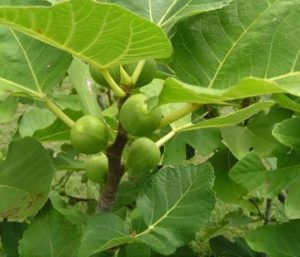BOTANICAL NAME: Ficus carica
FAMILY: Moraceae
ENGLISH NAME: Common fig
COMMON NAME:
Hindi: Anjeer
Bengali: Anjir
Kannad: Anjura

HABITAT: A moderate sized deciduous tree growing upto an height of 15- 20 feet.
BOTANICAL DESCRIPTION: Leaves broad, ovate 3-5 lobed leathery dark fruits axillary vary in color sweet juicy pear shaped, seeds are numerous real fruits in fig.
AYURVEDIC CHARACTERISTICS:
| RASA | GUNA | VEERYA | VIPAKA | PRABHAVA | DOSHGHNTA |
| Madhura | Guru , snigdha | Sheeta | Madhura | Mutrala | . |
AYURVEDIC ENERGETICS:
| TASTE | PROPERTY | POTENCY | POST DIGESTIVE EFFECT | EFFECT ACTION | DOSHA ACTION |
| Sweet | Heavy, unctuous | Cold | Sweet | Diuretic | Pacifying pitta and vata |
MAJOR CHEMICAL CONSTITUENTS: Plant contains protein , calcium, phosphorus vitamin A, ascorbic acid .
THERAPEUTIC USES:
- Warts, skin ulcers – The latex of figs applied externally over skin ulcers , sores.
- Pain and swelling– The paste prepared from the fruit of the plant is applied over joints affected with pain and swelling.
- Hemorrhage – The fresh juice is given to treat internal haemorrhage.
INDICATIONS:
Kamla Jaundice, Shotha Swelling, Sandhi vedana Joint pain, Vrana Ulcers
USEFUL PART: Roots, seeds, fruits
DOSAGE: juice : 10-20 ml
Fruit 2-3
Paste 5- 10ml
AYURVEDIC FORMULATION:
- Neelaa ghrita
- Gojihwadi kashaya
